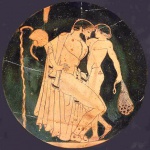Pederasty in ancient Athens: Difference between revisions
Dandelion moved page Athenian pederasty to Pederasty in Ancient Athens |
Replaced the redirect code with the new content of the page |
||
| Line 1: | Line 1: | ||
[[File:Man Holding a Flower Leads a Hare While Courting Boy.png|thumb|right|Man Holding a Flower Leads a Hare While Courting Boy. Attic red-figure cup by Makron, c. 480 B.C. Paris, Musée du Louvre, G 141.]] | |||
'''Athenian pederasty''' entailed a formal bond between an adult man and an adolescent boy outside his immediate family, consisting of an educational and often sexual relationship. As an erotic and mentoring custom, it was initially employed by the upper class as a means of teaching the young and conveying to them important cultural values, such as bravery and restraint. | |||
Athenian society generally encouraged the ''[[erastes]]'' ("lover"; [[Greece|Greek]]: ἐραστής, pl. ἐρασταί, ''erastai'') to pursue a boy to love, tolerating excesses like sleeping on the youth's stoop and otherwise going to great lengths to make himself noticed. At the same time, the boy and his family were expected to put up resistance and not give in too easily, and boys who succumbed too readily were looked down upon. As a result, the quest for a desirable ''[[eromenos]]'' ("beloved"; [[Greece|Greek]]: ἐρώμενος, pl. ἐρώμενοι, ''eromenoi'') was fiercely competitive.<ref>Yates, Velvet Lenore, "Anterastai: Competition in Eros and Politics in Classical Athens" in ''Arethusa'' Volume 38, Number 1, Winter 2005, pp. 33–47.</ref> | |||
==History and artistic record== | |||
[[File:395px-Pederastic courtship Louvre CA3096 n2.jpg|thumb|250px|left|"Up-and-down" gesture. Detail from an Attic black-figure cup, ca. 530–520 BCE. Paris, Musée du Louvre, CA3096.]] | |||
In Athens, as elsewhere, pederastic relationships had their beginnings among the aristocracy, but in time the practice was picked up by others sections of the population. With the advent of democracy, whose role models were the lovers and tyrant slayers [[Harmodius and Aristogeiton]], "access to gymnastic and sympotic culture widened, so the concomitant pederastic emotions and relationships may also have become more widely admired and imitated".<ref>Nick Fisher, ''Aeschines: Against Timarchos'', "Introduction", p. 27; Oxford University Press, 2001.</ref> | |||
A great deal of modern knowledge about Athenian pederastic practices has been derived from [[:Category:Art|ceramic paintings]] on vases depicting various forms and aspects of the relationship. These vases first appear about 560 BCE, a year after the pederastic tyrant Peisistratus seized power in Athens.<ref>Rommel Mendès-Leite et al. ''Gay Studies from the French Cultures'', p. 157.</ref> Their production ceased around 470 BCE, after which they either went out of fashion or were replaced with vases of precious metal which have not survived.<ref>William Armstrong Percy III, "Reconsiderations about Greek Homosexualities", in ''Same–Sex Desire and Love in Greco-Roman Antiquity and in the Classical Tradition of the West'', Binghamton, 2005; pp. 30–31</ref> | |||
The iconography attests to the dominant status of pederasty in Athenian social life. On the strict red-figure vases, [[Eros (mythology)|Eros]] only appears in scenes that show the interaction of men and adolescent boys.<ref>Adolf Furtwängler, ''Lexicon iconographicum mythologiae classicae'' I 1353.</ref> Wilhelm Kroll reports that ceramic depictions of individuals labeled as beautiful include only thirty of women and girls, ''καλή,'' but five hundred and twenty eight of boys, ''καλός.''<ref>Wilhelm Kroll "Knabenliebe" in Pauly-Wissowa, ''Realencyclopaedie der klassischen Altertumswissenschaft'', vol. 11, cols. 897–906 [http://www.well.com/user/aquarius/kroll-pederasty.htm].</ref> | |||
While John Boardman in his studies postulated the age of the depicted youths to range from 12 to 14, they are now believed to range in age from 14 to 18.<ref>Percy, 2005, p. 54.</ref> | |||
==Practice== | |||
[[File:Youth Fondles Boy While Offering Him a Rooster as Love Gift.png|thumb|right|Youth Fondles Boy While Offering Him a Rooster as Love Gift. Attic red-figure alabastron, Painter of Berlin 2268, ca. 500 BC, Munich 8954.]] | |||
{{History}} | |||
In Athens the practice of pederasty was more freely constructed than the more formal [[Ancient Crete|Cretan]] and [[Spartan pederasty|Spartan]] types.<ref>Thomas Scanlon, ''Eros and Greek Athletics'', Oxford, 2002; p. 213.</ref> Men courted boys at the ''[[Gymnasium (ancient Greece)|gymnasia]]'' or the ''[[palaestra|palaestrae]]'', at ''[[symposium|symposia]]'', at the [[Public bathing|baths]] and on the streets of the city. Fathers wanting to protect their sons from unwanted advances provided them with a slave guard, titled "pedagogos", to escort the boy in his travels. | |||
The courtship often was fiery, involving street fights with other suitors, sleeping on the threshold of the beloved as a show of sincerity, and composing and reciting love poems.<ref>Aeschines, ''Against Timarchos''.</ref> In encountering the boy, the suitor would attempt to seduce him by reaching up with one hand to turn his face to look him straight in the eye, and with the other reach down to stimulate him sexually, a variant of the standard pleading form in which one would grasp the knees of the person with one hand and turn his face with the other.<ref>A. Calimach, ''Lovers' Legends: The Gay Greek Myths'', p. 123.</ref> This ritual has been named by historians the "up and down gesture" and is routinely encountered in depictions on vases. | |||
The erotic and sexual aspect of the relationship, usually consisting of embracing, fondling and [[intercrural sex]], ended when the youth reached adulthood, and evolved into a lifelong friendship (''philia'').<ref>Vernon Provencal, "Glukus Himeros: Pederastic Influence on the Myth of Ganymede", in ''Same-Sex Desire and Love in Greco-Roman Antiquity and in the Classical Tradition of the West'', ed. B. C. Verstraete and V. Provencal, Harrington Park Press, 2005, pp. 64–70.</ref> | |||
==Law== | |||
A number of laws addressed the issue of relations between men and boys. None but citizens could engage free boys in pederastic relationships ("''A slave shall not be the lover of a free boy nor follow after him, or else he shall receive fifty blows of the public lash''"), and slaves likewise were forbidden from the wrestling schools ("''A slave shall not take exercise or anoint himself in the wrestling-schools''"). Both laws were attributed to Solon.<ref>Aeschines, ''Against Timarchos'' 1.138–139</ref><ref>Wilhelm Kroll "Knabenliebe" in Pauly-Wissowa, ''Realencyclopaedie der klassischen Altertumswissenschaft'', vol. 11, cols. 897–906 [http://www.well.com/user/aquarius/kroll-pederasty.htm].</ref> | |||
Commercial pederasty involving free boys was also forbidden. The relative who lent out a ward for illicit intercourse was punished. Boys who sold their favors (''hetaireesis'') risked losing most of their rights as citizens once come to adulthood. One surviving piece of Greek [[oratory]] documents a legal case, ''Against Timarchos,'' in which [[Aeschines]] pleads to enforce precisely that law against his opponent. ''Hubris'' (rape) was against the law not only in the case of free boys, but even with slaves.<ref>Ibid.</ref> | |||
In order to prevent teachers from taking advantage of their charges, a law was passed forbidding them from opening their schools before dawn or staying open past sunset. Likewise, there was a law threatening with death any man under forty who trespassed onto school grounds. | |||
:''See [http://depthome.brooklyn.cuny.edu/classics/dunkle/athnlife/edcation.htm] on the protection of Athenian boys against unlawful acts.'' | |||
==Politics== | |||
Pederastic couples were traditionally credited with standing up against tyrants. In Athens, [[Harmodius and Aristogiton|Harmodius and his ''erastes'', Aristogeiton]], were credited (perhaps symbolically) with the overthrow of the tyrant Hippias and the establishment of the democracy. Cratinus and Aristodemus were another pair of pederastic heroes. They sacrificed their lives to propitiate offended deities when a plague had fallen on Athens. | |||
The role of ''erastes'' was so far valued by the Athenians that even Pericles, a man who seems to have abstained from relationships with boys and loved women deeply, used the model of the erastes as an example for Athenians to follow in their relationship with their own city. In a funeral speech ascribed to him by Thucydides he exhorts the Athenians to "gaze day after day on the power of the city and become her ''[[erastes|erastai]]''", interpreted to mean that citizen-soldiers should behave towards Athens like boyfriends, i.e., love the city without calculation, more than life itself.<ref>James Davidson, "Mr and Mr and Mrs and Mrs" in ''London Review of Books'' June 2, 2005 [http://www.lrb.co.uk/v27/n11/davi02_.html] accessed Oct 1, 2007.</ref> | |||
==Morals== | |||
It was proper for the lover to respect the authority of the boy's father. According to Xenophon, "nothing [of what concerns the boy] is kept hidden from the father, by a noble lover".<ref>Xenophon, ''Symposium''.</ref> While it was expected that during courtship the lover would offer his boy small gifts, typically fighting cocks or edible delicacies, offering—and receiving—money or substantial gifts was considered disreputable in Athens and many other places, if not all. Apparently the boy could also send gifts to his man. An anecdote describes the jealous rage of Xanthippe, [[Socrates]]' wife, who destroys a cake sent by [[Alcibiades]], seeing it as a "present sent by an ''eromenos'' to his ''erastes'' to reinforce his passion".<ref>Aelian, ''Var. Hist'', 11.11.</ref> | |||
==In fiction== | |||
Athenian pederasty is a major theme in the historical novel ''[[The Last of the Wine]]'' by [[Mary Renault]]. | |||
==See also== | |||
*[[Ancient Greece]] | |||
*[[Pederasty]] | |||
*[[Pederasty in ancient Greece]] | |||
*[[Historical pederastic couples]] | |||
*[[Symposium]] | |||
*[[Philosophy of Greek pederasty]] | |||
*[[The Last of the Wine]] | |||
==Notes== | |||
{{reflist}} | |||
==Exturnal links== | |||
*[http://www.thefullwiki.org/Athenian_pederasty Athenian pederasty (the full wiki)] | |||
{{Navbox Pederasty|collapsed}} | |||
[[Category:Ancient Greece]] | |||
{{DEFAULTSORT:Ancient Greece}} | |||
Revision as of 17:04, 10 April 2019
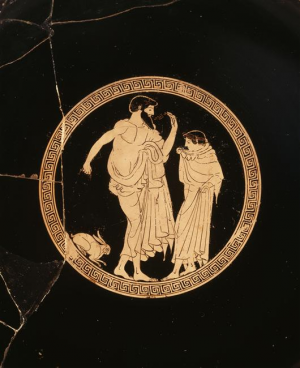
Athenian pederasty entailed a formal bond between an adult man and an adolescent boy outside his immediate family, consisting of an educational and often sexual relationship. As an erotic and mentoring custom, it was initially employed by the upper class as a means of teaching the young and conveying to them important cultural values, such as bravery and restraint.
Athenian society generally encouraged the erastes ("lover"; Greek: ἐραστής, pl. ἐρασταί, erastai) to pursue a boy to love, tolerating excesses like sleeping on the youth's stoop and otherwise going to great lengths to make himself noticed. At the same time, the boy and his family were expected to put up resistance and not give in too easily, and boys who succumbed too readily were looked down upon. As a result, the quest for a desirable eromenos ("beloved"; Greek: ἐρώμενος, pl. ἐρώμενοι, eromenoi) was fiercely competitive.[1]
History and artistic record
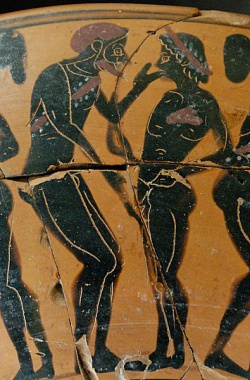
In Athens, as elsewhere, pederastic relationships had their beginnings among the aristocracy, but in time the practice was picked up by others sections of the population. With the advent of democracy, whose role models were the lovers and tyrant slayers Harmodius and Aristogeiton, "access to gymnastic and sympotic culture widened, so the concomitant pederastic emotions and relationships may also have become more widely admired and imitated".[2]
A great deal of modern knowledge about Athenian pederastic practices has been derived from ceramic paintings on vases depicting various forms and aspects of the relationship. These vases first appear about 560 BCE, a year after the pederastic tyrant Peisistratus seized power in Athens.[3] Their production ceased around 470 BCE, after which they either went out of fashion or were replaced with vases of precious metal which have not survived.[4]
The iconography attests to the dominant status of pederasty in Athenian social life. On the strict red-figure vases, Eros only appears in scenes that show the interaction of men and adolescent boys.[5] Wilhelm Kroll reports that ceramic depictions of individuals labeled as beautiful include only thirty of women and girls, καλή, but five hundred and twenty eight of boys, καλός.[6]
While John Boardman in his studies postulated the age of the depicted youths to range from 12 to 14, they are now believed to range in age from 14 to 18.[7]
Practice
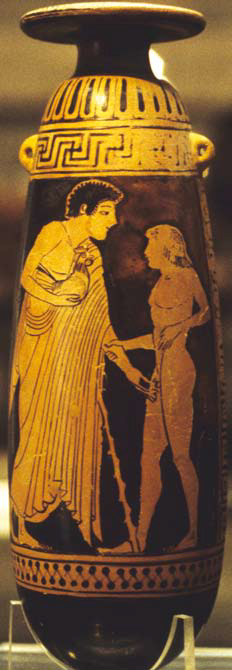
| Part of the boylove history series |
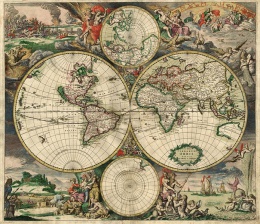 |
| Portal:History |
In Athens the practice of pederasty was more freely constructed than the more formal Cretan and Spartan types.[8] Men courted boys at the gymnasia or the palaestrae, at symposia, at the baths and on the streets of the city. Fathers wanting to protect their sons from unwanted advances provided them with a slave guard, titled "pedagogos", to escort the boy in his travels.
The courtship often was fiery, involving street fights with other suitors, sleeping on the threshold of the beloved as a show of sincerity, and composing and reciting love poems.[9] In encountering the boy, the suitor would attempt to seduce him by reaching up with one hand to turn his face to look him straight in the eye, and with the other reach down to stimulate him sexually, a variant of the standard pleading form in which one would grasp the knees of the person with one hand and turn his face with the other.[10] This ritual has been named by historians the "up and down gesture" and is routinely encountered in depictions on vases.
The erotic and sexual aspect of the relationship, usually consisting of embracing, fondling and intercrural sex, ended when the youth reached adulthood, and evolved into a lifelong friendship (philia).[11]
Law
A number of laws addressed the issue of relations between men and boys. None but citizens could engage free boys in pederastic relationships ("A slave shall not be the lover of a free boy nor follow after him, or else he shall receive fifty blows of the public lash"), and slaves likewise were forbidden from the wrestling schools ("A slave shall not take exercise or anoint himself in the wrestling-schools"). Both laws were attributed to Solon.[12][13]
Commercial pederasty involving free boys was also forbidden. The relative who lent out a ward for illicit intercourse was punished. Boys who sold their favors (hetaireesis) risked losing most of their rights as citizens once come to adulthood. One surviving piece of Greek oratory documents a legal case, Against Timarchos, in which Aeschines pleads to enforce precisely that law against his opponent. Hubris (rape) was against the law not only in the case of free boys, but even with slaves.[14]
In order to prevent teachers from taking advantage of their charges, a law was passed forbidding them from opening their schools before dawn or staying open past sunset. Likewise, there was a law threatening with death any man under forty who trespassed onto school grounds.
- See [4] on the protection of Athenian boys against unlawful acts.
Politics
Pederastic couples were traditionally credited with standing up against tyrants. In Athens, Harmodius and his erastes, Aristogeiton, were credited (perhaps symbolically) with the overthrow of the tyrant Hippias and the establishment of the democracy. Cratinus and Aristodemus were another pair of pederastic heroes. They sacrificed their lives to propitiate offended deities when a plague had fallen on Athens.
The role of erastes was so far valued by the Athenians that even Pericles, a man who seems to have abstained from relationships with boys and loved women deeply, used the model of the erastes as an example for Athenians to follow in their relationship with their own city. In a funeral speech ascribed to him by Thucydides he exhorts the Athenians to "gaze day after day on the power of the city and become her erastai", interpreted to mean that citizen-soldiers should behave towards Athens like boyfriends, i.e., love the city without calculation, more than life itself.[15]
Morals
It was proper for the lover to respect the authority of the boy's father. According to Xenophon, "nothing [of what concerns the boy] is kept hidden from the father, by a noble lover".[16] While it was expected that during courtship the lover would offer his boy small gifts, typically fighting cocks or edible delicacies, offering—and receiving—money or substantial gifts was considered disreputable in Athens and many other places, if not all. Apparently the boy could also send gifts to his man. An anecdote describes the jealous rage of Xanthippe, Socrates' wife, who destroys a cake sent by Alcibiades, seeing it as a "present sent by an eromenos to his erastes to reinforce his passion".[17]
In fiction
Athenian pederasty is a major theme in the historical novel The Last of the Wine by Mary Renault.
See also
- Ancient Greece
- Pederasty
- Pederasty in ancient Greece
- Historical pederastic couples
- Symposium
- Philosophy of Greek pederasty
- The Last of the Wine
Notes
- ↑ Yates, Velvet Lenore, "Anterastai: Competition in Eros and Politics in Classical Athens" in Arethusa Volume 38, Number 1, Winter 2005, pp. 33–47.
- ↑ Nick Fisher, Aeschines: Against Timarchos, "Introduction", p. 27; Oxford University Press, 2001.
- ↑ Rommel Mendès-Leite et al. Gay Studies from the French Cultures, p. 157.
- ↑ William Armstrong Percy III, "Reconsiderations about Greek Homosexualities", in Same–Sex Desire and Love in Greco-Roman Antiquity and in the Classical Tradition of the West, Binghamton, 2005; pp. 30–31
- ↑ Adolf Furtwängler, Lexicon iconographicum mythologiae classicae I 1353.
- ↑ Wilhelm Kroll "Knabenliebe" in Pauly-Wissowa, Realencyclopaedie der klassischen Altertumswissenschaft, vol. 11, cols. 897–906 [1].
- ↑ Percy, 2005, p. 54.
- ↑ Thomas Scanlon, Eros and Greek Athletics, Oxford, 2002; p. 213.
- ↑ Aeschines, Against Timarchos.
- ↑ A. Calimach, Lovers' Legends: The Gay Greek Myths, p. 123.
- ↑ Vernon Provencal, "Glukus Himeros: Pederastic Influence on the Myth of Ganymede", in Same-Sex Desire and Love in Greco-Roman Antiquity and in the Classical Tradition of the West, ed. B. C. Verstraete and V. Provencal, Harrington Park Press, 2005, pp. 64–70.
- ↑ Aeschines, Against Timarchos 1.138–139
- ↑ Wilhelm Kroll "Knabenliebe" in Pauly-Wissowa, Realencyclopaedie der klassischen Altertumswissenschaft, vol. 11, cols. 897–906 [2].
- ↑ Ibid.
- ↑ James Davidson, "Mr and Mr and Mrs and Mrs" in London Review of Books June 2, 2005 [3] accessed Oct 1, 2007.
- ↑ Xenophon, Symposium.
- ↑ Aelian, Var. Hist, 11.11.
Exturnal links
